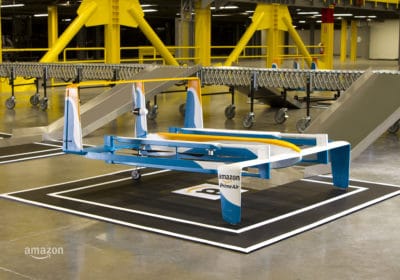(Bloomberg)—Drone deliveries got a step closer to reality as the White House issued an order giving local governments more authority to conduct tests of the burgeoning new technology.
President Donald Trump on Wednesday signed an executive order designed to speed the approval of drone flights over crowds and for longer distances. The administration says it wants to open new commercial uses for the aircraft and create jobs.
“In order to maintain American leadership in this emerging industry here at home, our country needs a regulatory framework that encourages innovation while ensuring airspace safety,” Michael Kratsios, a deputy assistant to the president at the Office of Science and Technology Policy, said in a briefing with reporters.
Trump’s order, a response to calls from companies making and using drones, will allow local governments to apply to the Federal Aviation Administration for waivers allowing them to conduct tests of deliveries, drone air-traffic systems, long-range flights and other uses generally prohibited under current rules, Kratsios said.
The move is the latest attempt to jump start an industry in which technology has moved at a rapid clip, only to be held back by regulatory and safety concerns. The government adopted rules allowing routine commercial flights last year, but with rare exceptions it limited operations to short distances and ordered that they be kept away from people.
While U.S. companies have been among the industry’s leaders, some have complained that restrictive federal regulations have slowed their ability to move forward. Companies including Amazon.com Inc., No. 1 in the Internet Retailer 2017 Top 500, and Alphabet Inc.’s Project Wing have at times had to test their drone-delivery systems in other countries. Project Wing is now testing Mexican food delivery via drone in Australia.
In addition to deliveries, drones can be tested for such uses as rushing medical supplies to emergencies, performing inspections of pipelines and power grids, and filming news events. Earlier this month, CNN was granted an FAA waiver allowing routine drone flights over people.
“Amazon supports the administration’s efforts to create a pilot program aimed at keeping America at the forefront of aviation and drone innovation,” Gur Kimchi, vice president of Amazon Prime Air, said in a statement.
The program will give state, local and tribal governments “a voice and a stake in the development of a federal regulatory framework for aviation,” Kratsios said. Details of how far the local agencies could go to press the federal regulators weren’t released, but their programs must be approved by the FAA.
The new program helps resolve some of the tensions over which governmental agencies will ultimately control drone operations by giving the FAA and its parent, the Department of Transportation, the ultimate authority, said Michael Drobac, executive director of the Small UAV Coalition.
“This is a good step,” Drobac said. “We needed to have some clarity and the administration needed to act.”
The program allows local officials to have input into drone operations in their communities “without infringing on the U.S. government’s jurisdiction over the national airspace,” said Brian Wynne, president and chief executive of the Association for Unmanned Vehicle Systems International.

An Amazon Prime Air drone
Rep. Jason Lewis, R-Minn., has proposed legislation giving communities more control over drone flights. He issued a press release saying the program didn’t go far enough. It should ensure local governments “have the ability to take effective action when it comes to putting in place reasonable limitations on public use,” Lewis said in the release.
In its announcement, the White House was at times critical of federal regulators and the program may pit Trump’s top officials against some federal agencies, including national security offices and the FAA. Kratsios said uses of drones have grown rapidly and more than a million were registered with the government, far exceeding the number of traditional aircraft.
“However, our aviation regulatory framework has not kept pace with this change,” he said.
One of the main reasons the FAA has moved slowly to allow expanded drone flights has been reservations by the FBI and security agencies concerned about them being used as terrorist weapons or for criminal activity. As a result, the FAA is trying to craft rules that would require at least some drones to broadcast their identity and position at all times.
Similarly, the FAA is grappling with growing safety concerns about drones. The first mid-air collision between a drone and a traditional aircraft occurred Sept. 21 near New York City. Earlier this month, the FAA cited growing numbers of reported safety incidents as justification for rapidly moving to a new system for approving flight waivers.
The data gathered in test flights will help with both this issues, according to the White House.
Trump’s order says Transportation Secretary Elaine Chao will approve at least five applications from local governments within six months. The applicants can propose using the drones themselves, such as a police or fire department, or can establish partnerships with businesses using the devices. Their operations should begin within 90 days.
The flights will mostly be limited to within 200 feet (61 meters) of the ground, the lowest tier of operations in U.S. airspace. Applicants can request flights as high as 400 feet. Most helicopters and other low-flying aircraft don’t go below 500 feet.
Applications for flights that currently aren’t permitted without FAA waivers will still undergo the same approval process.
Favorite
